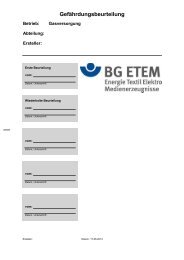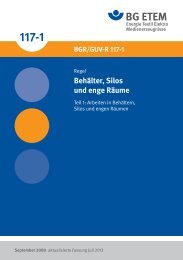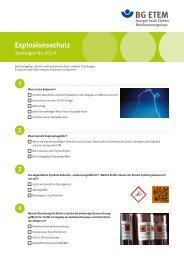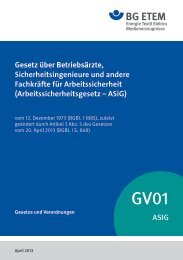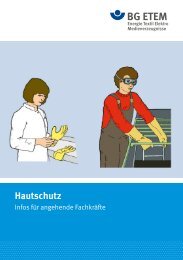2 What is an fault arc - Die BG ETEM
2 What is an fault arc - Die BG ETEM
2 What is an fault arc - Die BG ETEM
Create successful ePaper yourself
Turn your PDF publications into a flip-book with our unique Google optimized e-Paper software.
4 Arc thermal r<strong>is</strong>k parameters <strong>an</strong>d their evaluation<br />
Essential definitions <strong>an</strong>d terms are summarized in Annex 2.<br />
4.2 Calculation <strong>an</strong>d measurement of thermal r<strong>is</strong>k parameters<br />
In the st<strong>an</strong>dardized electric <strong>arc</strong> test methods copper calorimeters are used to measure<br />
the incident energy. The maximum value of the temperature r<strong>is</strong>e dTmax of the defined<br />
calorimeter copper d<strong>is</strong>c (delta peak temperature) <strong>is</strong> proportional to the incident<br />
energy Ei (see Figure 4.1):<br />
with<br />
14<br />
Ei =<br />
m . cp<br />
A<br />
. dTmax<br />
m – mass of calorimeter copper d<strong>is</strong>c<br />
A – cross sectional area of calorimeter copper d<strong>is</strong>c<br />
cp – specific heat capacity coefficient of copper<br />
dTmax – delta peak temperature (maximum temperature r<strong>is</strong>e) of the calorimeter.<br />
The delta peak temperature <strong>is</strong> the difference between the maximum temperature<br />
during the test exposure time of 30 s <strong>an</strong>d the initial temperature of the sensor.<br />
Fig. 4.1: Temperature r<strong>is</strong>e course during <strong>an</strong> <strong>arc</strong> test (example with sensor 1 directly exposed <strong>an</strong>d<br />
sensor 2 behind PPE)



